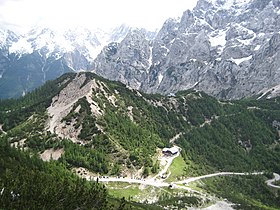Vršič Pass
Mountain pass across the Julian Alps in Slovenia From Wikipedia, the free encyclopedia
Mountain pass across the Julian Alps in Slovenia From Wikipedia, the free encyclopedia
The Vršič Pass (pronounced [ʋəɾˈʃitʃ]; Slovene: prelaz Vršič, Italian: passo della Moistrocca, German: Werschetzpass)[1] is a high mountain pass across the Julian Alps in northwestern Slovenia. It is the highest pass in Slovenia, with an elevation of 1,611 metres (5,285 ft), as well as the highest in the Eastern Julian Alps. It connects Upper Carniola with the Trenta Valley in the Slovene Littoral, and it is considered an excellent starting point for excursions to surrounding peaks. Over Vršič, there was an old trail, which was upgraded for military purposes as well as for logging and timber transportation in the early 20th century. The modern road, now known as the Russian Road (Ruska cesta), was built in 1915–17.[2][3]
| Vršič Pass | |
|---|---|
 The Vršič Pass | |
| Elevation | 1,611 m (5,285 ft) |
| Traversed by | Ruska cesta |
| Location | Upper Carniola, Slovenia |
| Range | Julian Alps |
| Coordinates | 46°26′8″N 13°44′40″E |
The Slovene common noun vršič literally means 'little peak', a diminutive form of the word vrh 'peak'. The name originally referred to Mount Vršič (1,738 m or 5,702 ft), located about 200 m (660 ft) east of the Vršič Pass. The name Vršič was not applied to the pass until 1911. The name of the peak was first attested in written sources as Werschez in 1763–87. Locally, the pass is known as Na močilu (first attested in 1763–87 as Muschizach or Mushizhach).[4] The Italian name of the pass was Moistrocca.
This section needs expansion. You can help by adding to it. (October 2015) |
After World War I, from 1918 to World War II, the Vršič Pass was on the border between Italy and Yugoslavia. Since 1945, together with the Upper Isonzo Valley north of Gorizia, it was incorporated in Yugoslavia, and then in Slovenia.
The Vršič Pass is considered an excellent starting point for excursions to surrounding peaks, including Mala Mojstrovka (2,332 m or 7,651 ft), Velika Mojstrovka (2,366 m or 7,762 ft), Planja (2,453 m or 8,048 ft), Prisojnik (Prisank) (2,547 m or 8,356 ft), Razor (2,601 m or 8,533 ft), Šitna Glava (2,087 m or 6,847 ft), Slemenova Špica (1,911 m or 6,270 ft), Sovna Glava (1,750 m or 5,740 ft), and Suhi Vrh (2,109 m or 6,919 ft), or shorter hikes in the immediate area.
Several mountain lodges are located near the pass: the Erjavec Lodge (Erjavčeva koča; 1,515 m or 4,970 ft), the Tičar Lodge (Tičarjev dom; 1,620 m or 5,310 ft), Mike's Lodge (Mihov dom), the Forest Lodge (Koča na Gozdu; 1,226 m or 4,022 ft), and the Postman's Lodge (Poštarska koča; 1,725 m or 5,659 ft).
The road through the pass rises from Kranjska Gora, traverses the top of the Vršič Pass, and descends into the Soča Valley, via a series of 50 hairpin bends. The upper elevations of the road are rendered impassable by heavy snowfall during much of winter. The road was greatly improved in late 1915 to supply the Isonzo Front of World War I, and it was originally named after Archduke Eugen of Austria-Hungary. The current name, Russian Road (Ruska cesta), refers to the approximately ten to twelve thousand Russian prisoners of war used as laborers in the 1915 construction.[5]
Just off the main road, on the north side of the pass, at an elevation of around 1,200 m (3,900 ft), there is a Russian Orthodox chapel, built by the Russian prisoners of war during World War I.
On the south side of the pass there is a bronze monument in honor of the mountaineer and writer Julius Kugy, work by the architect Boris Kobe and the sculptor Jakob Savinšek. It was erected in 1953.[6]
Seamless Wikipedia browsing. On steroids.
Every time you click a link to Wikipedia, Wiktionary or Wikiquote in your browser's search results, it will show the modern Wikiwand interface.
Wikiwand extension is a five stars, simple, with minimum permission required to keep your browsing private, safe and transparent.